Assessing Latency of Packet Delivery in the 5G 3GPP Integrated Access and Backhaul Architecture with Half-Duplex Constraints
Abstract
:1. Introduction
- The detailed queuing-based model for delay assessment in TDM-based IAB deployments with multiple network configurations and various time allocation strategies between access and backhaul;
- Numerical results showing a linear increase in the total packet delay on the uplink and downlink as the maximum number of network tiers (hops) increases, as well as a noticeable influence of the resource allocation scheme between access and backhaul, which requires further study;
- The impact of increasing the maximum number of IAB-nodes on the end-to-end delay strongly depends on the choice of the topology and requires maintaining the optimal ratio between the maximum number of hops and the average network load. Determining this ratio is subject to further research.
2. Background and Related Work
2.1. IAB Features and Standardization
- Multi-hop backhauling;
- Multiplexing of the access and backhaul links;
- Multi-beaming;
- Multi-connectivity.
2.2. Overview of Related Studies
- Topology management: Emphasis is placed on designing the network protocols and architecture, as well as the description of traffic control procedures.
- Route selection: When adopting multi-hop access technology, the classic problem of traffic routing and resource allocation in the RAN is complicated by the half-duplex constraint and the need to take into account the spectral efficiency due to wireless backhauling.
- Resource allocation between backhaul and access: Channel multiplexing and cross-link interference are proposed for study. Resource management in the context of interference avoidance is required because 5G NR can operate at relatively low frequencies, for which antenna arrays do not have such a high directivity as for mmWave. In the case of mmWave, the problem is largely solved by spacing the IAB-node antennas at a short distance away from each other [10].
- Spectral efficiency: The need for improving the existing mechanisms, such as modulation and coding schemes, is expressed. However, the report also emphasizes the importance of reusing standard NR solutions as much as possible.
2.2.1. Topology Management
2.2.2. Route Selection
2.2.3. Resource Allocation
2.2.4. Spectral Efficiency
2.2.5. Summary
3. System Model
3.1. IAB System Specifics
3.2. Topology Description
3.3. Packet Transmission
3.4. Time Division Duplexing and Multiplexing
- Transmitting to a network node (transmit backhaul);
- Receiving from a network node (receive backhaul);
- Transmitting to associated UEs (transmit access);
- Receiving from associated UEs (receive access).
3.5. Performance Metrics
- The total packet delay in the uplink defined as the time from the instant the packet joins the inbound access buffer in its sector to the instant it leaves the system;
- The total packet delay in the downlink defined as the time from the instant the packet joins a buffer in Node 1 to the instant it leaves the system via an access link.
4. Scenario and Parameterization
4.1. Considered Scenario
4.2. Parameterized TDM Pattern
- : transmit access;
- : receive access.
- : receive access;
- : transmit access.
- : (1,3) transmits backhaul, (2,1) receives backhaul;
- : (1,3) transmits access, (2,1) receives access;
- : (1,3) receives backhaul, (2,1) transmits backhaul;
- : (1,3) receive access, (2,1) transmits access.
4.3. Implementation Specifics and Data Collection
5. Numerical Results
- Topology #1: Tier 1: 2/3 T, Tier 2: 1/3 T.
- Topology #2: Tier 1: 5/6 T, Tier 2: 1/2 T, Tier 3: 1/3 T.
- Topology #3: Tier 1: 2/3 T, Tier 2: 1/2 T, Tier 3: 1/3 T.
- Topology #4: Tier 1: 5/6 T, Tier 2: 2/3 T, Tier 3: 1/2 T, tier 4: 1/6 T.
- 9 networks of Topology # 0 (only IAB-donor),
- 7 networks of Topology # 1 (IAB-donor + 3 IAB-nodes),
- 6 networks of Topology # 2 (IAB-donor + 5 IAB-nodes),
- 4 networks of Topology # 3 (IAB-donor + 7 IAB-nodes) or
- 2 networks of Topology # 4 (IAB-donor + 14 IAB-nodes).
6. Conclusions
Author Contributions
Funding
Data Availability Statement
Acknowledgments
Conflicts of Interest
References
- ITU-R. Minimum Requirements Related to Technical Performance for IMT-2020 Radio Interface. Technical Report M.2410-0. 2017. Available online: https://www.itu.int/dms_pub/itu-r/opb/rep/R-REP-M.2410-2017-PDF-E.pdf (accessed on 1 October 2022).
- Jin, H.; Huang, H.; Su, L.; Nahrstedt, K. Cost-Minimizing Mobile Access Point Deployment in Workflow-Based Mobile Sensor Networks. In Proceedings of the 2014 IEEE 22nd International Conference on Network Protocols, Raleigh, NC, USA, 21–24 October 2014; pp. 83–94. [Google Scholar] [CrossRef]
- Yang, X.; Lin, H.; Li, Z.; Qian, F.; Li, X.; He, Z.; Wu, X.; Wang, X.; Liu, Y.; Liao, Z.; et al. Mobile access bandwidth in practice: Measurement, analysis, and implications. In Proceedings of the ACM SIGCOMM 2022 Conference, Renton, WA, USA, 4–6 April 2022; pp. 114–128. [Google Scholar]
- Lopez, A.V.; Chervyakov, A.; Chance, G.; Verma, S.; Tang, Y. Opportunities and Challenges of mmWave NR. IEEE Wirel. Commun. 2019, 26, 4–6. [Google Scholar] [CrossRef]
- Nashiruddin, M.I.; Rahmawati, P.; Nugraha, M.A.; Akhmad, A. Deployment of 5G NR at mmWave Frequency for Mobile Network in Indonesia’s Market. In Proceedings of the 2021 2nd International Conference on ICT for Rural Development (IC-ICTRuDev), Virtual, 27–28 October 2021; pp. 1–6. [Google Scholar] [CrossRef]
- Ghoshal, M.; Kong, Z.J.; Xu, Q.; Lu, Z.; Aggarwal, S.; Khan, I.; Li, Y.; Hu, Y.C.; Koutsonikolas, D. An in-depth study of uplink performance of 5G mmWave networks. In Proceedings of the ACM SIGCOMM Workshop on 5G and Beyond Network Measurements, Modeling, and Use Cases, Amsterdam, The Netherlands, 22 August 2022; pp. 29–35. [Google Scholar]
- 3GPP TR 38.874 v16.0.0. NR; Study on Integrated Access and Backhaul. Technical Report. 2018. Available online: https://portal.3gpp.org/desktopmodules/Specifications/SpecificationDetails.aspx?specificationId=3232 (accessed on 1 October 2022).
- 3GPP TS 38.401 v17.0.0. Technical Specification Group Radio Access Network; NG-RAN; Architecture Description. 2022. Technical Specification. Available online: https://portal.3gpp.org/desktopmodules/Specifications/SpecificationDetails.aspx?specificationId=3219 (accessed on 1 October 2022).
- Gupta, M.; Rao, A.; Visotsky, E.; Ghosh, A.; Andrews, J.G. Learning Link Schedules in Self-Backhauled Millimeter Wave Cellular Networks. IEEE Trans. Wirel. Commun. 2020, 19, 8024–8038. [Google Scholar] [CrossRef]
- Sadovaya, Y.; Moltchanov, D.; Nikopour, H.; Yeh, S.p.; Mao, W.; Orhan, O.; Talwar, S.; Andreev, S. Self-Interference Assessment and Mitigation in 3GPP IAB Deployments. In Proceedings of the ICC 2021-IEEE International Conference on Communications, Montreal, QC, Canada, 14–23 June 2021; pp. 1–6. [Google Scholar]
- Łukowa, A.; Venkatasubramanian, V.; Visotsky, E.; Cudak, M. On the Coverage Extension of 5G Millimeter Wave Deployments Using Integrated Access and Backhaul. In Proceedings of the 2020 IEEE 31st Annual International Symposium on Personal, Indoor and Mobile Radio Communications, London, UK, 31 August–3 September 2020; pp. 1–7. [Google Scholar] [CrossRef]
- Kim, J.; Kim, I.; Chung, H. Resource Multiplexing Enhancements for Integrated Access and Backhaul in 5G New Radio Release 17. In Proceedings of the 2020 International Conference on Information and Communication Technology Convergence (ICTC), Jeju Island, Republic of Korea, 21–23 October 2020; pp. 936–938. [Google Scholar] [CrossRef]
- Rommel, S.; Cimoli, B.; Grivas, E.; Dodane, D.; Morales, A.; Pikasis, E.; Bourderionnet, J.; Feugnet, G.; Carvalho, J.B.; Katsikis, M.; et al. Real-Time Demonstration of ARoF Fronthaul for High-Bandwidth mm-Wave 5G NR Signal Transmission over Multi-Core Fiber. In Proceedings of the 2020 European Conference on Networks and Communications (EuCNC), Online, 15–18 June 2020; pp. 205–208. [Google Scholar] [CrossRef]
- 3GPP TS 38.174. Integrated Access and Backhaul Radio Transmission and Reception. Technical Report. 2020. Available online: https://portal.3gpp.org/desktopmodules/Specifications/SpecificationDetails.aspx?specificationId=3665 (accessed on 1 October 2022).
- Jayasinghe, P.; Tölli, A.; Kaleva, J.; Latva-Aho, M. Traffic Aware Beamformer Design for Flexible TDD-Based Integrated Access and Backhaul. IEEE Access 2020, 8, 205534–205549. [Google Scholar] [CrossRef]
- Zhang, S.; Xu, X.; Sun, M.; Tao, X.; Liu, C. Joint Spectrum and Power Allocation in 5G Integrated Access and Backhaul Networks at mmWave Band. In Proceedings of the 2020 IEEE 31st Annual International Symposium on Personal, Indoor and Mobile Radio Communications, London, UK, 31 August–3 September 2020; pp. 1–7. [Google Scholar] [CrossRef]
- Gómez-Cuba, F.; Zorzi, M. Twice Simulated Annealing Resource Allocation for mmWave Multi-hop Networks with Interference. In Proceedings of the ICC 2020—2020 IEEE International Conference on Communications (ICC), Dublin, Ireland, 7–11 June 2020; pp. 1–7. [Google Scholar] [CrossRef]
- Polese, M.; Giordani, M.; Zugno, T.; Roy, A.; Goyal, S.; Castor, D.; Zorzi, M. Integrated Access and Backhaul in 5G mmWave Networks: Potential and Challenges. IEEE Commun. Mag. 2020, 58, 62–68. [Google Scholar] [CrossRef]
- Yin, H.; Roy, S.; Cao, L. Routing and Resource Allocation for IAB Multi-Hop Network in 5G Advanced. IEEE Trans. Commun. 2022, 70, 6704–6717. [Google Scholar] [CrossRef]
- Zhai, B.; Yu, M.; Tang, A.; Wang, X. Mesh Architecture for Efficient Integrated Access and Backhaul Networking. In Proceedings of the 2020 IEEE Wireless Communications and Networking Conference (WCNC), Seoul, Republic of Korea, 25–28 May 2020; pp. 1–6. [Google Scholar] [CrossRef]
- Liu, Y.; Tang, A.; Wang, X. Joint Incentive and Resource Allocation Design for User Provided Network Under 5G Integrated Access and Backhaul Networks. IEEE Trans. Netw. Sci. Eng. 2020, 7, 673–685. [Google Scholar] [CrossRef]
- Guo, H.; Makki, B.; Svensson, T. Predictor Antennas for Moving Relays: Finite Block-length Analysis. In Proceedings of the 2020 3rd International Conference on Advanced Communication Technologies and Networking (CommNet), Marrakech, Morocco, 4–6 September 2020; pp. 1–8. [Google Scholar] [CrossRef]
- Guo, H.; Makki, B.; Alouini, M.S.; Svensson, T. On Delay-Limited Average Rate of HARQ-Based Predictor Antenna Systems. IEEE Wirel. Commun. Lett. 2021, 10, 1628–1632. [Google Scholar] [CrossRef]
- Zhang, Q.; Ma, W.; Feng, Z.; Han, Z. Backhaul-Capacity-Aware Interference Mitigation Framework in 6G Cellular Internet of Things. IEEE Internet Things J. 2021, 8, 10071–10084. [Google Scholar] [CrossRef]
- Sahoo, B.P.S.; Swain, S.; Wei, H.Y.; Sarkar, M. Medium Access Strategies for Integrated Access and Backhaul at mmWaves Unlicensed Spectrum. In Proceedings of the 2021 Wireless Telecommunications Symposium (WTS), Virtual, 21–23 April 2021; pp. 1–6. [Google Scholar] [CrossRef]
- Mao, W.; Narasimha, M.; Simsek, M.; Nikopour, H. Network Coding for Integrated Access and Backhaul Wireless Networks. In Proceedings of the 2020 29th Wireless and Optical Communications Conference (WOCC), Newark, NJ, USA, 1–2 May 2020; pp. 1–6. [Google Scholar] [CrossRef]
- Huang, C.; Wang, X. A Bayesian Approach to the Design of Backhauling Topology for 5G IAB Networks. IEEE Trans. Mob. Comput. 2021. [Google Scholar] [CrossRef]
- Tafintsev, N.; Moltchanov, D.; Simsek, M.; Yeh, S.P.; Andreev, S.; Koucheryavy, Y.; Valkama, M. Reinforcement Learning for Improved UAV-Based Integrated Access and Backhaul Operation. In Proceedings of the 2020 IEEE International Conference on Communications Workshops (ICC Workshops), Dublin, Ireland, 7–11 June 2020; pp. 1–7. [Google Scholar] [CrossRef]
- Mandawaria, V.; Majumdar, C.; Chaudhari, A.; Sharma, N.; Nigam, A.; Jung, B.; Jung, J. Performance Evaluation of B5G Moving Networks with Spatial Consistency and Random Blockages. In Proceedings of the 2021 IEEE Wireless Communications and Networking Conference (WCNC), Nanjing, China, 29 March–1 April 2021; pp. 1–6. [Google Scholar]
- Choi, M.; Yoon, B.; Kim, D.; Sung, D. IAB-based Railway Communication Method for Stable Service Provision. In Proceedings of the 2021 Twelfth International Conference on Ubiquitous and Future Networks (ICUFN), Jeju Island, Republic of Korea, 17–20 August 2021; pp. 176–178. [Google Scholar] [CrossRef]
- Diamanti, M.; Charatsaris, P.; Tsiropoulou, E.E.; Papavassiliou, S. The Prospect of Reconfigurable Intelligent Surfaces in Integrated Access and Backhaul Networks. IEEE Trans. Green Commun. Netw. 2021, 6, 859–872. [Google Scholar] [CrossRef]
- Tan, A.S.; Biyar, E.D. QoS-Aware Autonomous IAB-Node Activation and Access Control. In Proceedings of the 2021 IEEE International Conference on Communications Workshops (ICC Workshops), Montreal, QC, Canada, 14–23 June 2021; pp. 1–6. [Google Scholar] [CrossRef]
- Alqasir, A.; Aldubaikhy, K.; Kamal, A.E. Integrated Access and Backhauling with Energy Harvesting and Dynamic Sleeping in HetNets. In Proceedings of the ICC 2021—IEEE International Conference on Communications, Montreal, QC, Canada, 14–23 June 2021; pp. 1–6. [Google Scholar] [CrossRef]
- Ranjan, S.; Chaporkar, P.; Jha, P.; Karandikar, A. Backhaul-Aware Cell Selection Policies in 5G IAB Networks. In Proceedings of the 2021 IEEE Wireless Communications and Networking Conference (WCNC), Nanjing, China, 29 March–1 April 2021; pp. 1–6. [Google Scholar] [CrossRef]
- Choi, M.; Chung, H. Relay Node Load Balancing Method in Mobile Communication Environment. In Proceedings of the 2021 International Conference on Information and Communication Technology Convergence (ICTC), Jeju Island, Republic of Korea, 20–22 October 2021; pp. 1415–1417. [Google Scholar] [CrossRef]
- Noh, H.; Lee, M.S. Beam Management for IAB Network in 5G-Advanced Wireless Communication Systems. In Proceedings of the 2021 International Conference on Information and Communication Technology Convergence (ICTC), Jeju Island, Republic of Korea, 20–22 October 2021; pp. 624–627. [Google Scholar] [CrossRef]
- Sande, M.M.; Hlophe, M.C.; Maharaj, B.T. Instantaneous Load-Based User Association in Multi-Hop IAB Networks using Reinforcement Learning. In Proceedings of the GLOBECOM 2020—2020 IEEE Global Communications Conference, Taipei, Taiwan, 7–11 December 2020; pp. 1–6. [Google Scholar] [CrossRef]
- Chen, L.; Diao, X.; Chen, J.; Liu, R. QoS Assurance in IAB Network. In Proceedings of the 2020 International Wireless Communications and Mobile Computing (IWCMC), Limassol, Cyprus, 15–19 June 2020; pp. 1860–1865. [Google Scholar]
- Lai, J.Y.; Wu, W.H.; Su, Y.T. Resource Allocation and Node Placement in Multi-Hop Heterogeneous Integrated-Access-and-Backhaul Networks. IEEE Access 2020, 8, 122937–122958. [Google Scholar] [CrossRef]
- Simsek, M.; Orhan, O.; Nassar, M.; Elibol, O.; Nikopour, H. IAB Topology Design: A Graph Embedding and Deep Reinforcement Learning Approach. IEEE Commun. Lett. 2021, 25, 489–493. [Google Scholar] [CrossRef]
- Madapatha, C.; Makki, B.; Fang, C.; Teyeb, O.; Dahlman, E.; Alouini, M.S.; Svensson, T. On Integrated Access and Backhaul Networks: Current Status and Potentials. IEEE Open J. Commun. Soc. 2020, 1, 1374–1389. [Google Scholar] [CrossRef]
- Madapatha, C.; Makki, B.; Muhammad, A.; Dahlman, E.; Alouini, M.S.; Svensson, T. On Topology Optimization and Routing in Integrated Access and Backhaul Networks: A Genetic Algorithm-Based Approach. IEEE Open J. Commun. Soc. 2021, 2, 2273–2291. [Google Scholar] [CrossRef]
- Fang, C.; Madapatha, C.; Makki, B.; Svensson, T. Joint Scheduling and Throughput Maximization in Self-backhauled Millimeter Wave Cellular Networks. In Proceedings of the 2021 17th International Symposium on Wireless Communication Systems (ISWCS), Berlin, Germany, 6–9 September 2021; pp. 1–6. [Google Scholar] [CrossRef]
- Pagin, M.; Zugno, T.; Polese, M.; Zorzi, M. Resource Management for 5G NR Integrated Access and Backhaul: A Semi-centralized Approach. IEEE Trans. Wirel. Commun. 2021, 21, 753–767. [Google Scholar] [CrossRef]
- Zhang, Y.; Ramamurthi, V.; Huang, Z.; Ghosal, D. Co-Optimizing Performance and Fairness Using Weighted Pf Scheduling And Iab-Aware Flow Control. In Proceedings of the 2020 IEEE Wireless Communications and Networking Conference (WCNC), Seoul, Republic of Korea, 25–28 May 2020; pp. 1–6. [Google Scholar] [CrossRef]
- Zhang, B.; Devoti, F.; Filippini, I. RL-based Resource Allocation in mmWave 5G IAB Networks. In Proceedings of the 2020 Mediterranean Communication and Computer Networking Conference (MedComNet), Arona, Italy, 17–19 June 2020; pp. 1–8. [Google Scholar] [CrossRef]
- Estupinan, D.; Jaramillo-Ramirez, D.; Puerta, R. Performance evaluation for 5G FWA in Quasi Static mmWave Channels: OFDM vs SC-QAM. In Proceedings of the 2020 IEEE Latin-American Conference on Communications (LATINCOM), Santo Domingo, Dominican Republic, 18–20 November 2020; pp. 1–6. [Google Scholar] [CrossRef]
- Sande, M.M.; Hlophe, M.C.; Maharaj, B.T. Access and Radio Resource Management for IAB Networks Using Deep Reinforcement Learning. IEEE Access 2021, 9, 114218–114234. [Google Scholar] [CrossRef]
- Yadav, I.; Chaporkar, P.; Jha, P.; Karandikar, A. Spectrum Allocation in IAB Networks: A Hierarchical Auction-based Approach. In Proceedings of the 2021 IEEE 94th Vehicular Technology Conference (VTC2021-Fall), Norman, OK, USA, 27–30 September 2021; pp. 1–5. [Google Scholar] [CrossRef]
- Cheng, Q.; Wei, Z.; Yuan, J. Deep Reinforcement Learning-based Spectrum Allocation and Power Management for IAB Networks. In Proceedings of the 2021 IEEE International Conference on Communications Workshops (ICC Workshops), Montreal, QC, Canada, 14–23 June 2021; pp. 1–6. [Google Scholar] [CrossRef]
- Yin, B.; Wang, N.; Fan, Y.; Sun, X.; He, D.; Liu, W. Evaluation of TDM-based Integrated Access and Backhaul Schemes for 5G and Beyond at mmWave Band. In Proceedings of the 2020 International Conference on Cyber-Enabled Distributed Computing and Knowledge Discovery (CyberC), Chongqing, China, 17–19 September 2020; pp. 348–353. [Google Scholar] [CrossRef]
- Zhang, J.; Luo, H.; Garg, N.; Holm, M.; Ratnarajah, T. Design and Analysis of mmWave Full-Duplex Integrated Access and Backhaul Networks. In Proceedings of the ICC 2021—IEEE International Conference on Communications, Montreal, QC, Canada, 14–23 June 2021; pp. 1–6. [Google Scholar] [CrossRef]
- Bishnu, A.; Holm, M.; Ratnarajah, T. Performance Evaluation of Full-Duplex IAB Multi-Cell and Multi-User Network for FR2 Band. IEEE Access 2021, 9, 72269–72283. [Google Scholar] [CrossRef]
- Askar, R.; Chung, J.; Guo, Z.; Ko, H.; Keusgen, W.; Haustein, T. Interference Handling Challenges toward Full Duplex Evolution in 5G and Beyond Cellular Networks. IEEE Wirel. Commun. 2021, 28, 51–59. [Google Scholar] [CrossRef]
- Inoue, T. 5G NR Release 16 and Millimeter Wave Integrated Access and Backhaul. In Proceedings of the 2020 IEEE Radio and Wireless Symposium (RWS), San Antonio, TX, USA, 26–29 January 2020; pp. 56–59. [Google Scholar] [CrossRef]
- Lei, W.; Ye, Y.; Xiao, M. Deep Reinforcement Learning-Based Spectrum Allocation in Integrated Access and Backhaul Networks. IEEE Trans. Cogn. Commun. Netw. 2020, 6, 970–979. [Google Scholar] [CrossRef]
- Zhang, J.; Luo, H.; Garg, N.; Bishnu, A.; Holm, M.; Ratnarajah, T. Design and Analysis of Wideband In-Band-Full-Duplex FR2-IAB Networks. IEEE Trans. Wirel. Commun. 2021, 21, 4183–4196. [Google Scholar] [CrossRef]
- Zhang, J.; Garg, N.; Holm, M.; Ratnarajah, T. Nyström Method-Based Hybrid Precoding for mmWave Full-Duplex Integrated Access and Backhaul Systems. In Proceedings of the 2021 IEEE Wireless Communications and Networking Conference (WCNC), Nanjing, China, 29 March–1 April 2021; pp. 1–6. [Google Scholar] [CrossRef]
- Zhang, J.; Garg, N.; Holm, M.; Ratnarajah, T. Design of Full Duplex Millimeter-Wave Integrated Access and Backhaul Networks. IEEE Wirel. Commun. 2021, 28, 60–67. [Google Scholar] [CrossRef]
- Sheemar, C.K.; Slock, D. Massive MIMO mmWave Full Duplex Relay for IAB with Limited Dynamic Range. In Proceedings of the 2021 11th IFIP International Conference on New Technologies, Mobility and Security (NTMS), Paris, France, 19–21 April 2021; pp. 1–5. [Google Scholar] [CrossRef]
- Garg, R.; Jain, S.; Dania, P.; Natarajan, A. 14.3 A 26 GHz Full-Duplex Circulator Receiver with 53 dB/400 MHz(40 dB/800 MHz) Self-Interference Cancellation for mm-Wave Repeaters. In Proceedings of the 2021 IEEE International Solid- State Circuits Conference (ISSCC), San Francisco, CA, USA, 13–22 February 2021; Volume 64, pp. 222–224. [Google Scholar]
- 3GPP. NR; Multi-Connectivity; Stage 2 (Release 16). 3GPP TS 37.340 V16.0.0, 3GPP . 2019. Available online: https://portal.3gpp.org/desktopmodules/Specifications/SpecificationDetails.aspx?specificationId=3198 (accessed on 1 October 2022).
- Sadovaya, Y.; Moltchanov, D.; Mao, W.; Orhan, O.; Yeh, S.P.; Nikopour, H.; Talwar, S.; Andreev, S. Integrated Access and Backhaul in Millimeter-Wave Cellular: Benefits and Challenges. IEEE Commun. Mag. 2022, 60, 81–86. [Google Scholar] [CrossRef]
- Wikipedia. Manhattan. 2022. Available online: https://en.wikipedia.org/wiki/Manhattan (accessed on 25 June 2022).
- Perros, H.G. Computer Simulation Techniques: The Definitive Introduction! 2009. Available online: https://repository.lib.ncsu.edu/handle/1840.2/2542 (accessed on 1 October 2022).
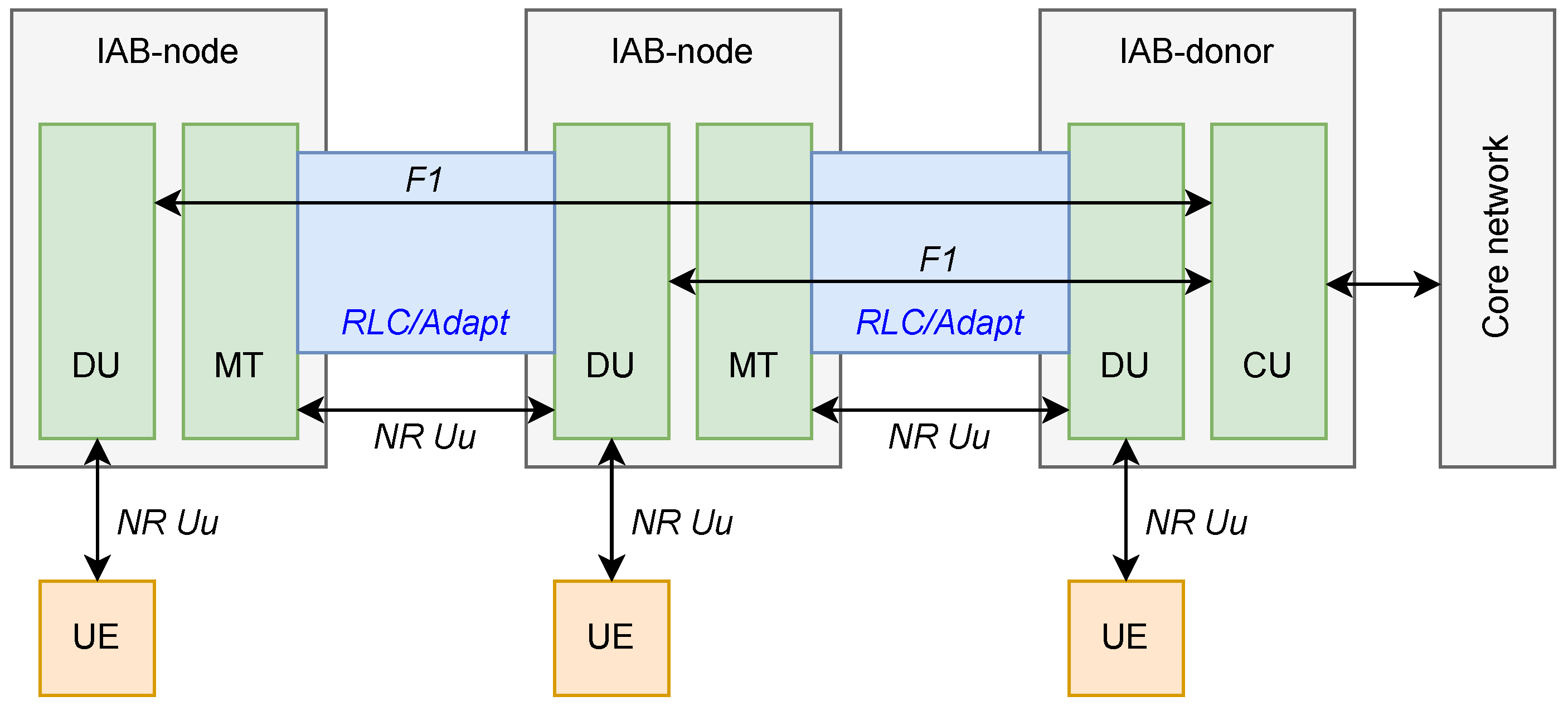
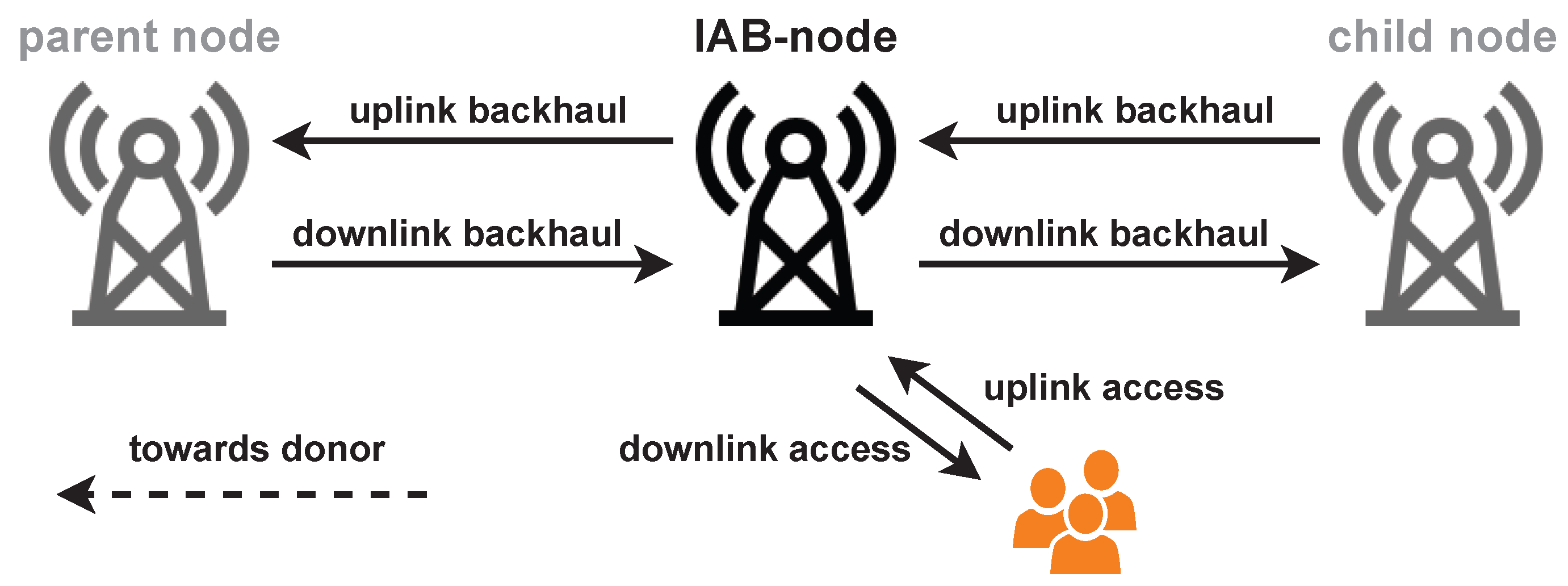
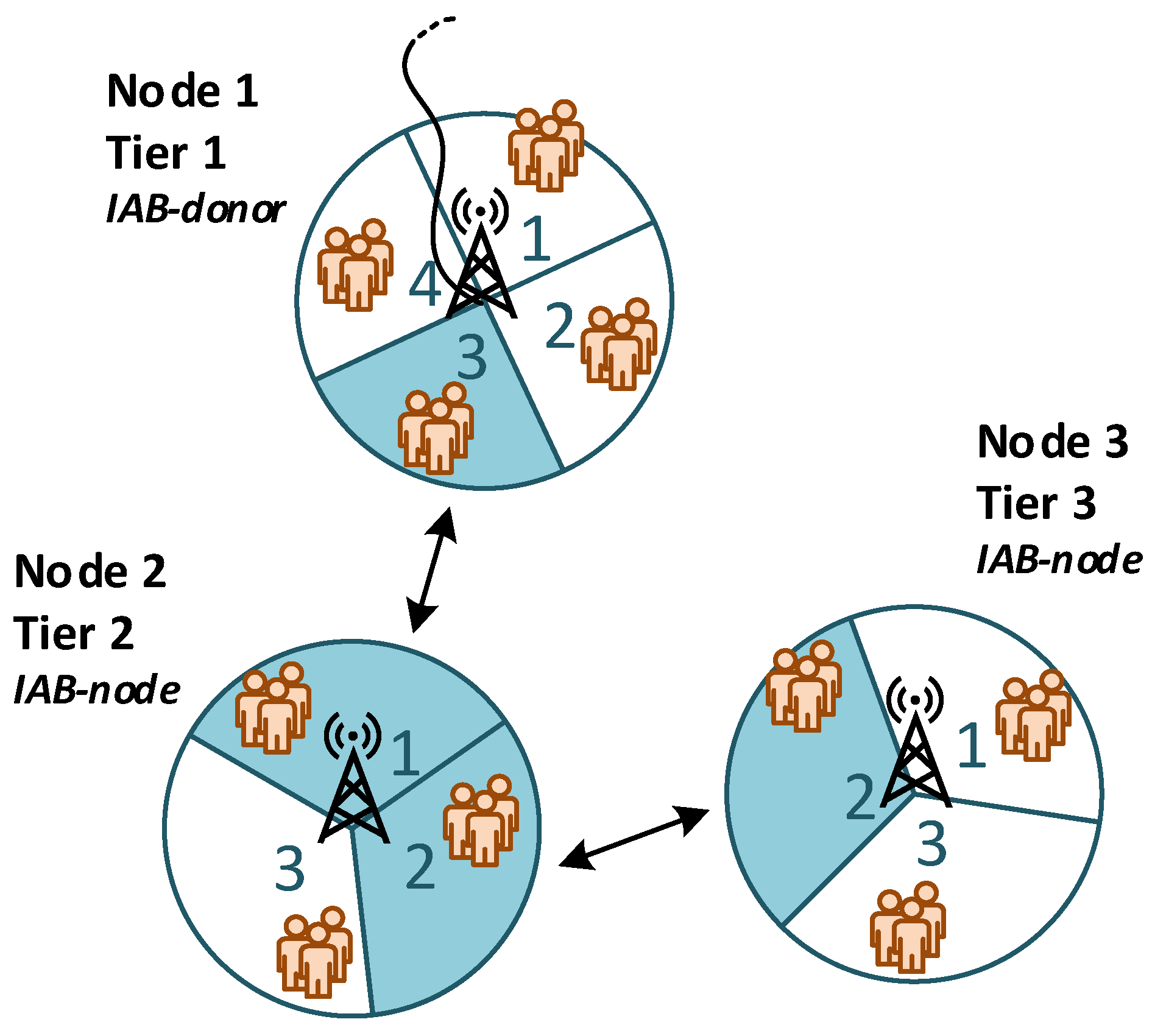

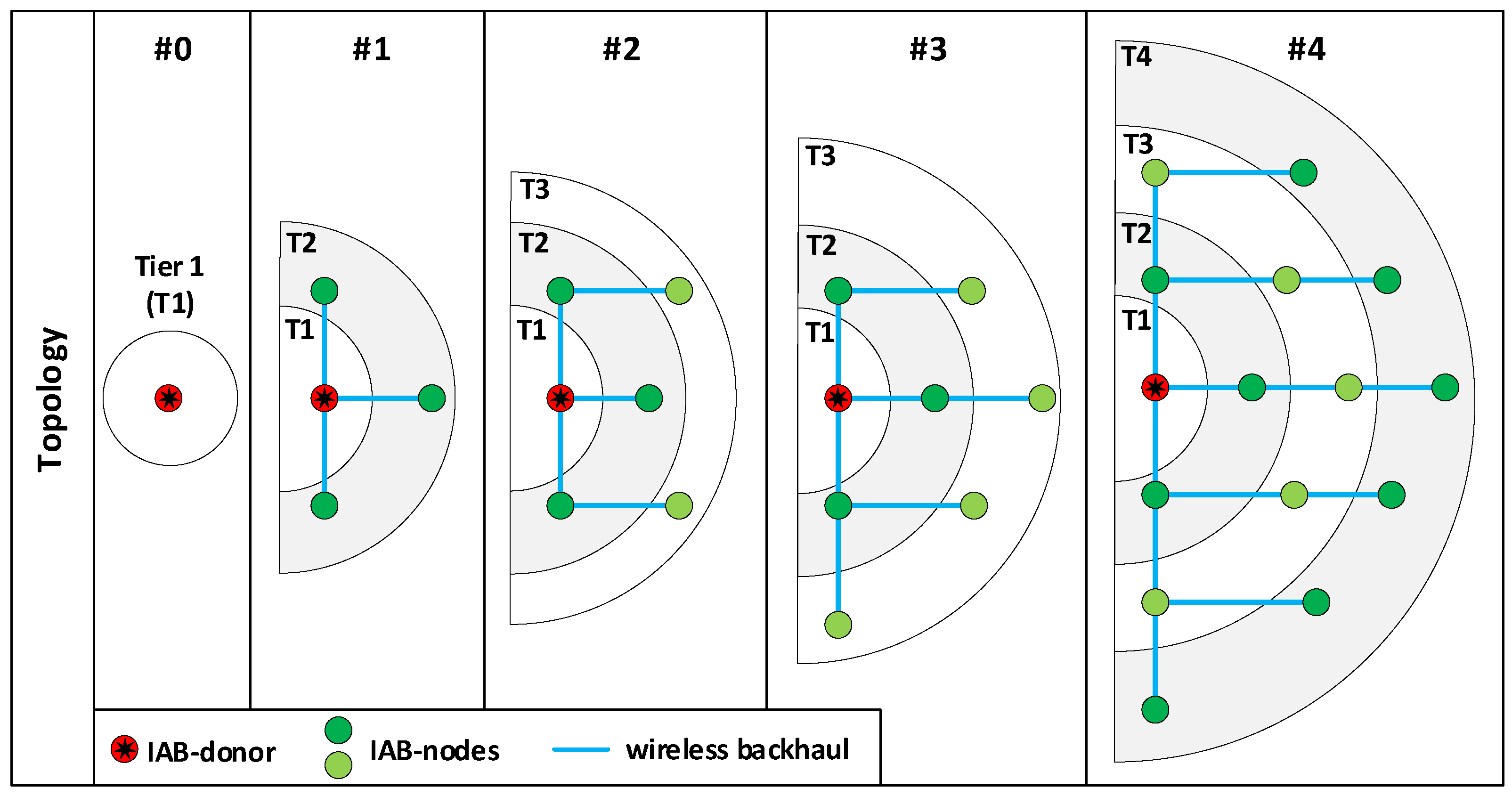

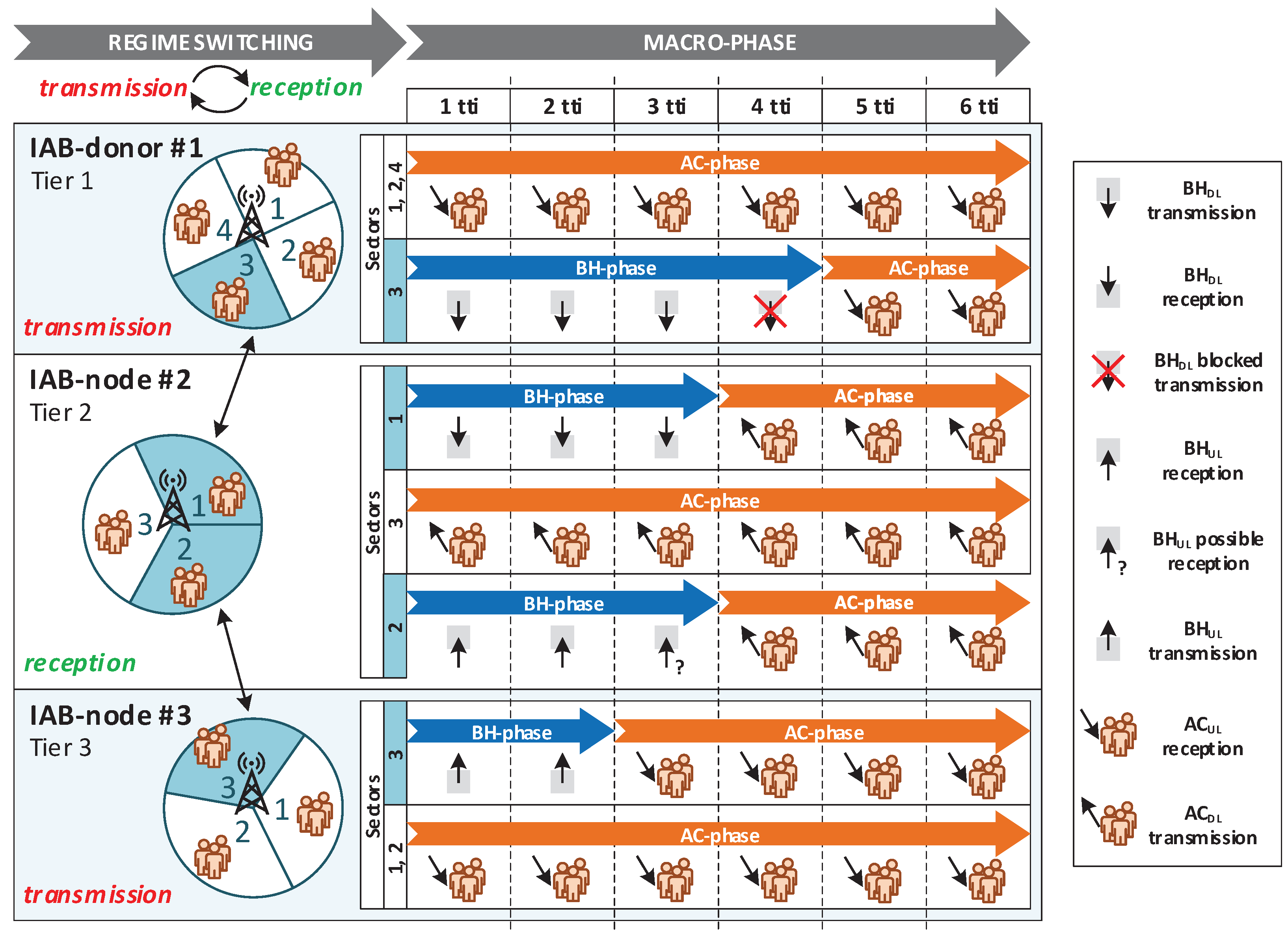

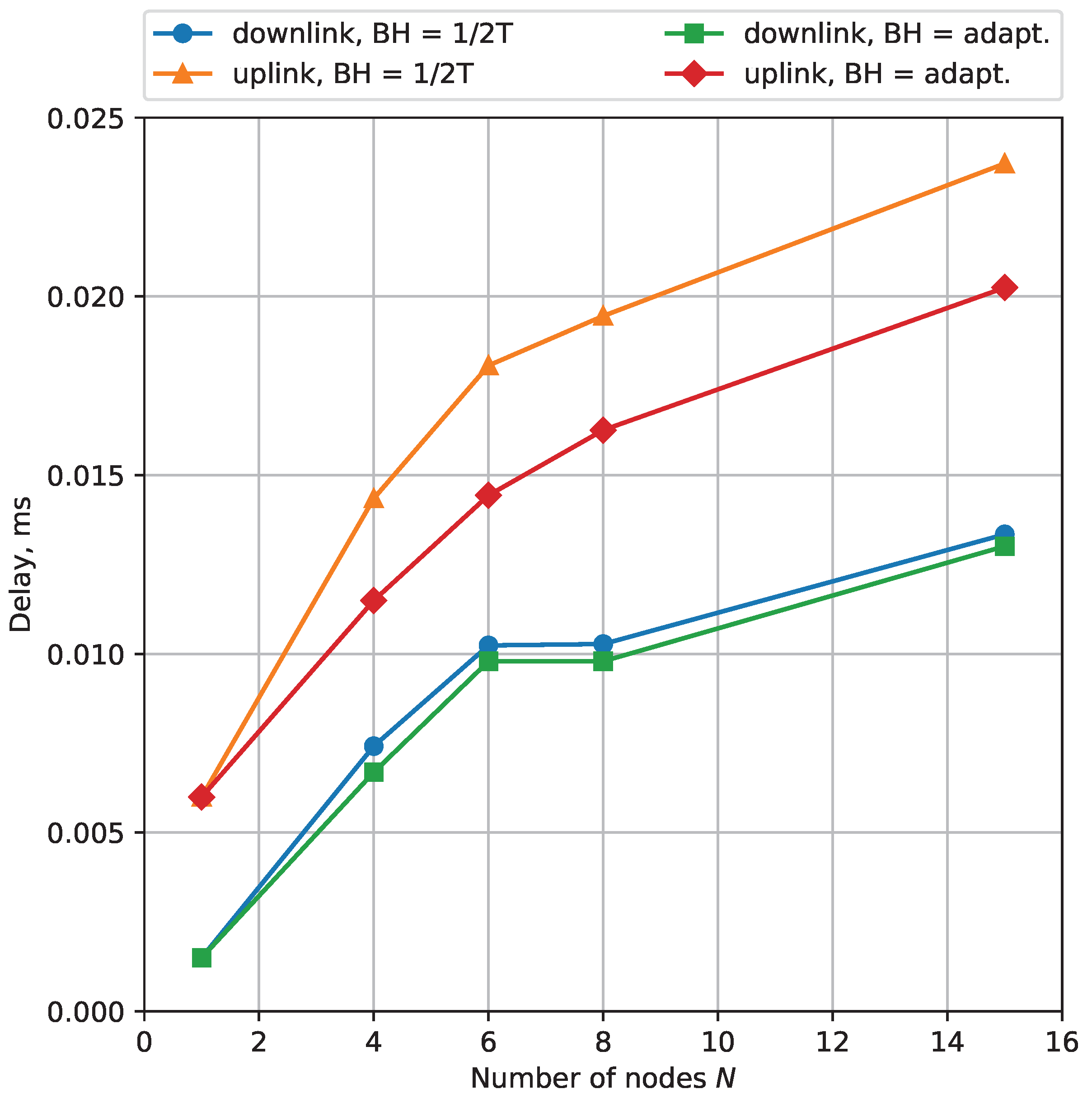

| Challenge | Sub-Problem | Related Papers | |
|---|---|---|---|
| Half-Duplex Assumed | Full-Duplex Assumed | ||
| Topology management | Protocols and architecture design | [20,21,22,23,24,25] | [26,27,28,29,30,31] |
| Control and user plane procedures for multi-hop traffic forwarding and QoS handling | [32,33,34,35,36] | [37,38] | |
| Route selection | Management of backhaul links and dynamic route selection and benefit evaluation | [9,39,40,41,42,43,44,45,46] | N/A |
| Resource allocation | Multiplexing | [11,12,47] | [48,49,50] |
| Cross-link interference | [10,15,16,17,51] | [52,53,54,55,56] | |
| Spectral efficiency | Physical Layer solutions or enhancements | N/A | [57,58,59,60,61] |
| Start Time | End Time | Sector | Sector |
|---|---|---|---|
| transmit backhaul | receive backhaul | ||
| transmit access | receive access | ||
| receive backhaul | transmit backhaul | ||
| receive access | transmit access |
Publisher’s Note: MDPI stays neutral with regard to jurisdictional claims in published maps and institutional affiliations. |
© 2022 by the authors. Licensee MDPI, Basel, Switzerland. This article is an open access article distributed under the terms and conditions of the Creative Commons Attribution (CC BY) license (https://creativecommons.org/licenses/by/4.0/).
Share and Cite
Polyakov, N.; Platonova, A. Assessing Latency of Packet Delivery in the 5G 3GPP Integrated Access and Backhaul Architecture with Half-Duplex Constraints. Future Internet 2022, 14, 345. https://doi.org/10.3390/fi14110345
Polyakov N, Platonova A. Assessing Latency of Packet Delivery in the 5G 3GPP Integrated Access and Backhaul Architecture with Half-Duplex Constraints. Future Internet. 2022; 14(11):345. https://doi.org/10.3390/fi14110345
Chicago/Turabian StylePolyakov, Nikita, and Anna Platonova. 2022. "Assessing Latency of Packet Delivery in the 5G 3GPP Integrated Access and Backhaul Architecture with Half-Duplex Constraints" Future Internet 14, no. 11: 345. https://doi.org/10.3390/fi14110345
APA StylePolyakov, N., & Platonova, A. (2022). Assessing Latency of Packet Delivery in the 5G 3GPP Integrated Access and Backhaul Architecture with Half-Duplex Constraints. Future Internet, 14(11), 345. https://doi.org/10.3390/fi14110345






